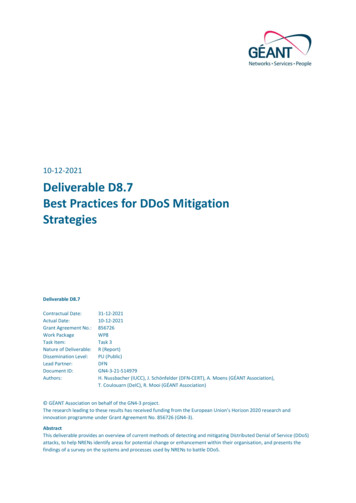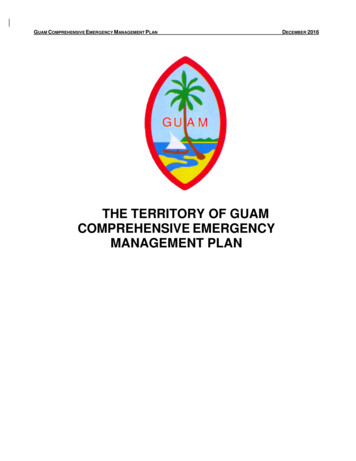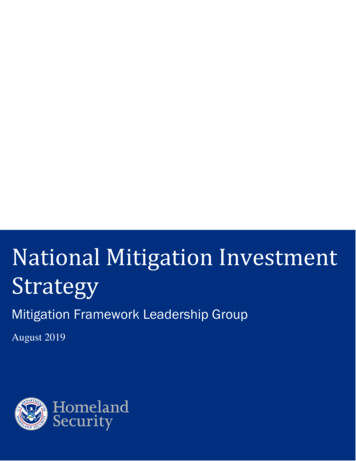
Transcription
ENVIRONMENTAL ENHANCEMENTAND MITIGATION PROGRAM2022 Grant CycleGUIDELINES AND PROJECT PROPOSALState of CaliforniaCalifornia Natural Resources AgencyApril 2022
(Intentionally left blank)
These guidelines include information to assist applicants in applying for funding. Please readthem in their entirety for important information on project eligibility, evaluation criteria, andsubmission requirements.For general project evaluation process questions, contact the California Natural ResourcesAgency at:Phone:(916) te: http://resources.ca.gov/grants/HOW TO SUBMIT A PROJECT PROPOSALThis grant program includes a progressive, three-step evaluation process:Step 1:Step 2:Step 3:Project ProposalsField VisitsSupporting DocumentsAll documents are submitted using the Natural Resources Agency’s System for OnlineApplication Review (SOAR), which can be found at: https://soar.resources.ca.gov.Applicants must create a SOAR user account. A detailed SOAR user manual is located on theNatural Resources Agency’s website at rces.SOAR SYSTEM QUESTIONSFor technical assistance with SOAR, please call or e-mail the SOAR help desk.Hours:Phone:Email:9:00 am to 5:00 pm M-F(916) 653-6138soar.admin@resources.ca.govWhen contacting the SOAR help desk, provide the following: Proposal Identification Number (PIN) assigned to the Project ProposalName of the Grant ProgramShort description of the problem, including where it is occurring within the ProjectProposalA screen shot of the error received, if applicable.TECHNICAL ASSISTANCE WORKSHOPSThe Natural Resource Agency will conduct virtual technical assistance workshops. A list ofworkshop dates and times can be found on the Natural Resources Agency website nhancement-and-mitigation-eem.i
TABLE OF CONTENTSIntroduction. 1Statutory Requirements . 1Selection Process . 8Evaluation/Scoring Criteria . 9Step 1: Project Proposal . 10Step 2: Field Visits (Qualifying Projects Only) . 21Step 3: Supporting Documentation (Qualifying Projects Only) . 22Project Administration (Post Grant Award) . 24State Audit and Accounting Requirements . 26Appendices for Step 1: Project Proposal . 28Appendix A: Submittal Checklist for Project Proposal . 29Appendix B: Letter from the Lead Agency . 30Appendix C: Environmental Compliance . 32Appendix D: Sample Cost Estimate (Development Projects) . 33Appendix E: Sample Cost Estimate (Acquisition Projects) . 34Appendix F: Eligible Costs . 35Appendix G: Willing Seller Letter . 38Appendices for Step 3: Supporting Documentation (Qualifying Projects Only) . 39Appendix H: Resolution Template . 40Appendix I: Certification Letter Requirements . 41Appendix J: Property Data Sheet . 42Appendix K: Site Control/Land Tenure Requirements . 43Appendix L: Project Permit Approval Status. 44Appendix M: Sign Guidelines. 45Appendix N: Memorandum of Unrecorded Grant Agreement Template(Development Projects) . 47Appendix O: Deed Restrictions Template (Acquisitions) . 49Appendix P: Payee Data Record/Government Agency Taxpayer ID Form . 50Appendix Q: Available Resources . 51Appendix R: Definitions . 53ii
INTRODUCTIONThese procedures and criteria guide the evaluation and selection of projects under theEnvironmental Enhancement and Mitigation (EEM) Program.This program, as provided by California Streets and Highways Code Section 164.56 (Article XIX,Section 1, of the State Constitution), authorizes the legislature to allocate up to 7 million eachfiscal year from the Highway Users Tax Account (Motor Vehicle Revenues, Section 2100).EEM projects must contribute to mitigation of the environmental effects of transportation facilities.The California Natural Resources Agency (Agency) prescribes procedures and criteria toevaluate grant project proposals and submits a list of projects recommended for funding to theCalifornia Transportation Commission (CTC). The CTC awards grants to projects from Agency’slist.Maximum AwardsGrants for individual projects are generally limited to 500,000 each. Applicants must submit aCost Estimate (Appendix D for Development Projects or Appendix E for Acquisition Projects)itemizing the total EEM project cost, the portion to be funded by the EEM Program grant, and theamount to be funded from other specified sources.A. Matching Funds - Matching funds are not required for EEM Program grants. However, projectproposals which include other sources of funds for the proposed project may be morecompetitive.B.Other Funding Sources - Applicants who have obtained, or are planning to obtain, othersources of funds for a project should identify each source of funding separately on the CostEstimate (Appendix D or E), including other State of California funds and in-kind contributions.C. Acquisitions - Agency may recommend awards up to 1,000,000 for acquisition projects,based on consideration of numerous factors, including, but not limited to, maximum benefitsin a one-time or limited opportunity, acquisition of resource lands of considerable size,substantial leveraging, and/or projects with statewide significance.STATUATORY REQUIREMENTSEligible ApplicantsLocal, state, and federal agencies and 501(c)(3) nonprofit entities may apply for and receivegrants. The applicant entity is not required to be a transportation- or highway-related organizationbut must be able to demonstrate adequate charter or enabling authority to carry out the typeof project proposed and be eligible for funding under Article XIX of the State Constitution.Partnerships are encouraged; however, a project proposal can only be submitted by one entity.For Development projects, only one project proposal may be submitted per eligible applicant.However, more than one project proposal may be submitted per eligible applicant for Acquisitionprojects.Eligible ProjectsEligible EEM projects must fit one of the following categories:1
A. Urban Forestry - projects designed to offset vehicular emissions of carbon dioxide.B.Resource Lands - projects for the acquisition or enhancement of resource lands to mitigatethe loss of, or the detriment to, resource lands lying within the right-of-way acquired fortransportation improvements.C. Mitigation Projects Beyond the Scope of the Lead Agency - projects to mitigate the impactof proposed Transportation Facilities or to enhance the environment, where the ability toeffectuate the mitigation or enhancement measures is beyond the scope of the lead agencyresponsible for assessing the environmental impact of the proposed transportationimprovement.Related Transportation FacilityEvery EEM project must mitigate, either directly or indirectly, the environmental impacts of themodification of an existing Transportation Facility or the environmental impacts of theconstruction of a new Transportation Facility (hereafter referred to as Related TransportationFacility or RTF). The EEM project can be the required mitigation for the RTF or enhancement tomitigation required for the RTF.A. For purposes of this program, an RTF is defined as a public street, highway, mass transitguideway (trains, ports, light rail lines, city streets, airports, etc.) or their appurtenant features(e.g., park-and-ride facilities, high-occupancy vehicle lanes, transit stations, etc.).B.The RTF cannot be the same as the EEM project.C. “Directly” and “indirectly” refer to:1.The geographic location of the two projects, andDirectlyThe EEM project is in the immediatevicinity of the RTF 12.IndirectlyThe EEM project is in the generalarea of the RTFThe type of benefit produced by the two projects.DirectlyThe EEM project replaces same habitatlost during the construction of the RTFIndirectlyThe EEM project will protect nearbyhabitat and open space to mitigatefor adverse impacts to habitat duringconstruction of the RTF (similarhabitat, same watershed, etc.)D. Applicants can identify eligible RTFs by contacting their city or county TransportationDepartment, Regional Transit Agency, Metropolitan Transit Authority (MTA), Council of LocalGovernments (COG), Metropolitan Planning Organization (MPO), or Caltrans District Office.1The closer the proposed EEM project is to the RTF, the more competitive the project proposal.2
Please give the transportation agency sufficient lead time to provide the requireddocumentation.E.F.Applicants are responsible for demonstrating the connection between the RTF and the EEMproject.1.Applicants must describe the RTF thoroughly and provide location maps or site plans.2.Applicants must establish there was an environmental impact caused by the RTF.Applicants must show what environmental impacts the RTF created and what mitigationwas required by law.3.The more directly the EEM project mitigates the environmental damage, the higher theproject will score on those criteria.The RTF must be a project:1.In which construction began after January 1, 1990; or2.Which is not yet under construction but is included in an adopted State TransportationImprovement Program (STIP) or in a locally adopted regional transportation improvementprogram and certified capital outlay program.G. If the RTF is being constructed in separate and distinct phases, each phase may beconsidered a separate project for purposes of this program, provided that each phasecreates an operable transportation improvement.H. Environmental Review for the RTFEnvironmental Review compliance (CEQA) must be completed for the RTF at the time ofproject proposal submission, even if construction of the RTF has not yet begun. A Letter fromthe Lead Agency for the RTF documenting the actual or anticipated environmental impacts(Appendix B) must be submitted with the project proposal package and establish:1.What environmental damage the RTF created or is anticipated to create; and2.What mitigation was required or is anticipated to be required.Not all transportation facility projects qualify as an RTF. Projects that are strictly replacementconstruction or which fall into the category of "maintenance" would not qualify. Additionally,a project which in itself mitigates an environmental impact would not qualify. Onlytransportation facility projects that result in adverse environmental impacts qualify as an RTFfor purposes of this grant program.For example, pavement resurfacing, repainting a bridge or a replanting project would not,under most circumstances, create an adverse environmental impact and would beconsidered maintenance. A bicycle lane or a sound barrier, which in itself mitigates anenvironmental impact, would not qualify as an RTF.In contrast, projects which involve a significant change in the capacity, configuration, orphysical lay-out of the transportation facility may qualify as an RTF.For example, widening a highway, adding a High Occupancy Vehicle (HOV) lane, orconstructing a frontage road likely would have an adverse environmental impact and mayqualify as an RTF.3
I.Under circumstances where a transportation project’s environmental review resulted in aNegative Declaration or Categorical Exemption and did not require mitigation, Applicantsmay be aware of cumulative impacts which had unforeseen adverse environmentalimpacts. In such a case, the project might be eligible for EEM Program funding if applicants:1.Establish the cumulative impacts of the RTF; and2.Demonstrate how the EEM project would mitigate for those cumulative impacts.For example, an EEM project may propose to offset the cumulative impacts of atransportation project which resulted in an unforeseen increase in urban traffic or in accidentsinvolving animals in a wildlife corridor.J.Applicants are required to demonstrate either:1.Construction of the RTF has, or will have, a significant, immediate adverse impact on theenvironment; or2.The RTF itself will have a long-term adverse impact on the environment.North/South SplitPursuant to sections 187 and 188 of the Streets and Highways Code, an attempt will be made toaward 40 percent of the total funding to projects in northern counties and 60 percent of the totalfunding to projects in southern counties. The following are defined as southern counties: San LuisObispo, Kern, Mono, Tulare, Inyo, Santa Barbara, Ventura, Los Angeles, San Bernardino, Orange,Riverside, San Diego, and Imperial. All other counties are considered northern counties.Minimum RequirementsProjects must meet all of the following minimum requirements to be considered for funding.1.Applicants must establish and demonstrate a direct or indirect relationship between theEEM project and the modification or construction of an RTF.2.The RTF must have an adverse impact on the environment.3.The EEM project must be different from the RTF.4.The EEM project must mitigate the environmental damage caused by the RTF.5.The EEM project, if in or near the RTF right-of-way, must be compatible with and notinterfere with the operation or safety of the RTF.6.The EEM project must not limit currently planned or anticipated future improvements tothe RTF.7.The EEM project must comply with the Model Water Efficient Landscape Ordinance(MWELO) or local agency landscape water ordinance (if as strict or stricter than MWELO)and use low-water, drought-tolerant plantings. The use of non-native plantings requirejustification. Trees planted must be in containers no larger than 15 gallons, regardless offunding source.8.If the EEM project is located on a state-owned right-of-way, applicable state design andconstruction standards and practices must apply.4
9.If the EEM project is not located on a state-owned right-of-way, applicable design andconstruction standards and practices of the local government having jurisdiction overthe project location shall apply.10. The EEM project must comply with the California Environmental Quality Act (CEQA),Division 13 (commencing with Section 21000). CEQA review for the proposed EEM projectmust be complete at the time of project proposal submission. Filed CEQA documentsmust be included as part of the project proposal (see Appendix C).Statewide Project GoalsAgency grant programs assist state and local entities in developing more sustainablecommunities, increasing their adaptability to climate change, and protecting biodiversity whileimproving quality of life in those communities. EEM Projects that demonstrate the followingmultiple benefits will be more competitive: Decreased air and/or water pollution. Reduced consumption of natural resources and energy. Increased reliability of local water supplies. Increased adaptability to climate change. Increased protection of biodiversityExamples of Eligible ProjectsThe list below provides examples of project elements that meet statutory conditions. It is not acomprehensive list.Urban Forestry: Planting of trees and other plants along urban streets and medians. Greening existing public lands and structures, including school campuses and urbanparks. Greening vacant lots and abandoned sites. Restoration of urban creeks.Resource Lands: Removal of invasive and restoration of natural plant species. Enhancement or restoration of natural areas such as inland wetlands, forests, oakwoodlands, mountain meadows, creeks, and streams with riparian or riverine fish orwildlife habitat, wildlife corridors and fish passages, coastal estuaries, grazing land andgrasslands. Acquisitions in fee title or through conservation easements to safeguard regional watersupplies, protect riparian and wildlife habitats, conserve agricultural lands for securewildlife migration corridors, and provide public access for compatible wildlife/natureoriented recreation by the wider community. Acquisitions to preserve in perpetuity Resource Lands for agricultural uses, open space,wetlands, biodiversity, etc.5
Mitigation Projects Beyond the Scope of the Lead Agency:Any of the project examples listed under Urban Forestry and Resource Lands categories may beeligible under the Mitigation Projects Beyond the Scope of the Lead Agency category, if themitigation or enhancement measures for the RTF were either not feasible or beyond thejurisdiction and/or authority of the Lead Agency for the RTF.Carbon Offset ProjectsAt the sole discretion of Agency, carbon offset projects within the project area may be allowedfor improved forest management projects. Projects will be more competitive where all proceedsof carbon sales in the project area will be used towards the purchase of the property,conservation easement, or other valuable restriction running with the land (so long as this doesnot exceed fair market value when coupled with State acquisition funds) or where all proceedswill be reinvested into the project for restoration, management, or monitoring. Agency mustreview and approve terms included in the conservation easement prior to depositing grant fundsinto escrow. For evaluation purposes, applicants must disclose in their project proposal plans forcarbon offset projects in the project area.Examples of Ineligible ProjectsThe list below provides examples of projects and elements that are not eligible under the EEMProgram. It is not a comprehensive list. Projects with no specific RTF clearly identified or where construction of the RTF startedbefore 1990. Project proposals that do not clearly demonstrate a connection between environmentaldamage caused by the RTF and the proposed EEM project. Projects where CEQA has not been completed. Planning-only, or operation and maintenance-only projects. Commuter trails. Projects that plant invasive plants or trees, or plant for aesthetic purposes only. Projects to construct parking lots or bridges (may be funded only as a necessary but minorcomponent). Educational or training programs. Projects that create or improve roads for motorized use. Acquisition of property that cannot be purchased at or below fair market value. Acquisition of property from a person or entity that does not own the property at the timeof Project Proposal submission. Development projects contingent on future acquisition for project implementation. Projects that include both acquisition and development (must be one or the other, notboth). Acquisitions involving eminent domain. Projects that are intended to correct problems caused by inadequate maintenance. Project proposals that include more than one project.6
Projects where applicantsdevelop/maintain project site.cannotdemonstratesatisfactorypermissionto Resource Lands projects in which the RTF does not specifically impact “Resource Lands”.Other Funding ConsiderationsIn evaluating projects, scores are used to determine initial rankings and facilitate discussions foreach proposal. To achieve equitable distribution of funds, the State may consider additionalfactors including, but not limited to, economic benefits, statewide significance, geographicdistribution of funds, previous grant performance, existing grants, disadvantaged communitystatus, and other potential project benefits, as well as feasibility to accept partial funding.All projects must:1.Comply with the California Environmental Quality Act (CEQA).2.Comply with all labor codes.3.Provide public access, where feasible.4.Engage with the local community to develop and support the project.5.Provide multiple benefits (environmental, social, health benefits, etc.) to the community.6.Comply with the Model Water Efficient Landscape Ordinance (MWELO) or local agencylandscape water ordinance (if as strict or stricter) and use low water, drought tolerantplantings.7.Be developed on parcels that are contiguous.In addition, acquisition projects must:1.Be acquired from a willing seller in an amount at or below fair market value, as approvedby the state.2.Include parcels that are contiguous.3.Once funds are awarded and a grant agreement signed with the state, another propertycannot be substituted for the property specified in the project proposal. It is imperativeapplicants demonstrate the seller is negotiating in good faith and discussions betweenthe parties have proceeded to a point of confidence.Website addresses and links to legislation and other available resource and reference materialscan be found in Appendix Q.7
SELECTION PROCESSStep 1 Applicants submit Project Proposals through the System for Online Application Review(SOAR). No hardcopy Project Proposals are required. Project Proposals are reviewed and evaluated. Incomplete or ineligible Project Proposalsmay be removed from the competitive process.Step 2 Field visits are conducted for the most competitive projects. Applicants may be requiredto provide site control documents or other documentation prior to a field visit.Step 3 Applicants selected to further compete submit additional documentation. Documentation is evaluated, with the most competitive projects being recommendedfor funding.Once Step 3 evaluations have been completed, recommendations for funding are submitted tothe California Secretary for Natural Resources (Secretary). The Secretary makes fundingrecommendations to the CTC. The CTC approves the recommendations and grant awards areannounced.All information contained in the project proposal and supporting documentation is confidentialuntil grant awards are announced.The State reserves the right to reject an applicant who is in violation of law or policy at any otherpublic agency. Potential violations include, but are not limited to, being in default ofperformance requirements in other contracts or grant agreements issued by the State, beingengaged in or suspected of criminal conduct that could poorly reflect on or bring discredit to theState or failing to have all required licenses necessary to carry out the project.The State further reserves the right to reject any applicant who has a history of performance issueswith past grants or other agreements with any public entity.Tribal ConsultationFor projects that affect tribal communities, Grantees will be required to show meaningfuloutreach and attempt to collaborate with local California Native American tribes through theimplementation of their project.Meaningful outreach includes, but is not limited to, writing letters and emails, and following withphone calls updating the tribe throughout the life of the project, inviting tribal leadership toattend planning meetings, and meeting with local tribal government lead consortiums or otherinter-tribal governmental organizations. Collaborating with local California Native Americantribes can include developing the project with tribal leadership, ensuring the project providesbenefits to the local tribe and its membership, and providing contracting opportunities to localtribes and their members where appropriate.Conflict of InterestAll applicants and individuals who participate in the review of submitted project proposals aresubject to state and federal conflict of interest laws. Any individual who has participated in8
planning or setting priorities for a specific solicitation over and above the public commentprocess or who will participate in any part of the grant development and negotiation process onbehalf of the public is ineligible to receive funds or personally benefit from funds through thatsolicitation. Failure to comply with conflict-of-interest laws, including business and financialdisclosure provisions, will result in the project proposal being rejected from consideration, and anysubsequent grant agreement being declared void. Other legal actions may also be taken.Applicable statutes include, but are not limited to, California Government Code section 1090 andPublic Contract Code sections 10365.5, 10410, and 10411. Applicants should also be aware thatcertain state agencies may submit project proposals that will compete for funding.EVALUATION/SCORING CRITERIAInformation provided during the evaluation process should demonstrate how effectively theproposed project meets statutory requirements and program objectives. Projects will beevaluated using the established criteria and any additional funding considerations. Projects willreceive an initial ranking, with a score of 100 points possible. The initial ranking will be used tofacilitate discussions about each proposal among a multidisciplinary team. Points will beattributed to each section and not to individual questions.General Criteria. 0-45 Mitigation and Enhancement . 0-15 Statewide Project Goals . 0-10 Other Sources of Funds/Local Cash Contributions . 0-5 Project Readiness/Organizational Capacity . 0-15Project Criteria . 0-55 Urban Forestryo Suitability. 0-20o Sustainability . 0-20o Cost Effectiveness . 0-10o Other Benefits and Community Participation . 0-5 Resource Landso Resource Value of Lands Lost or Injured by the RTF. 0-10o Resource Value of EEM Project Lands . 0-20o Sustainability . 0-10o Cost Effectiveness . 0-10o Other Benefits and Community Participation . 0-5 Mitigation Project Beyond the Scope of the Lead Agencyo Suitability. 0-5o Elements of Mitigation . 0-20o Sustainability . 0-15o Cost Effectiveness . 0-10o Other Benefits and Community Participation . 0-5Total Points Possible. 1009
STEP 1: PROJECT PROPOSALApplicants are required to submit an online project proposal in SOAR (System for OnlineApplication Review). Applicants should refer to the solicitation notice for the submission due date.No hard copies of the Project Proposal are required. Applicants proposing the most competitiveeligible projects will be invited to compete in the next phase of the evaluation process, whichincludes a field visit. The most competitive projects that receive a field visit may be invited tosubmit additional supporting documentation to continue in the competitive process.All Project Proposals will include the following:Project SummaryDescribe the discrete EEM project including expected project deliverables, current siteconditions, and extent of public access, if applicable. Include a brief description of therelationship to the RTF and how the EEM project mitigates for the environmental damage causedby the RTF. Summaries are limited to 3,000 characters.Project QuestionsA. General Criteria QuestionsApplicants must answer all the questions
project proposal submission, even if construction of the RTF has not yet begun. A Letter from the Lead Agency for the RTF documenting the actual or anticipated environmental impacts (Appendix B) must be submitted with the project proposal package and establish: 1. What environmental damage the RTF created or is anticipated to create; and . 2.
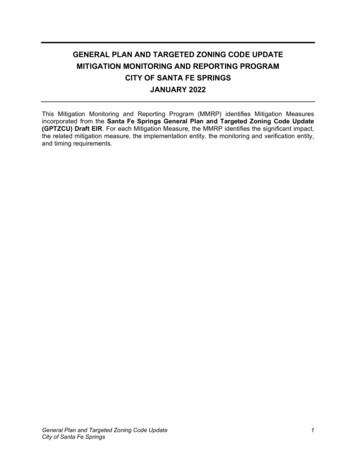
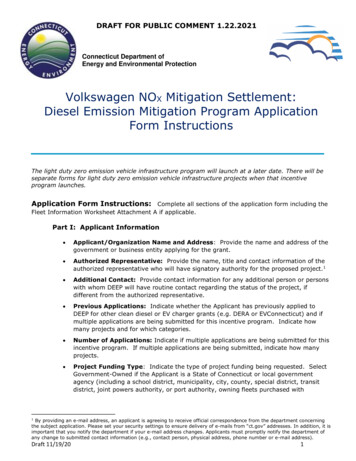
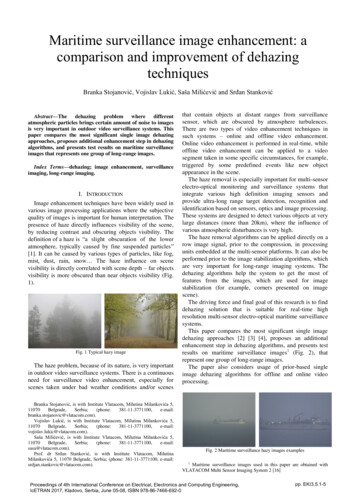
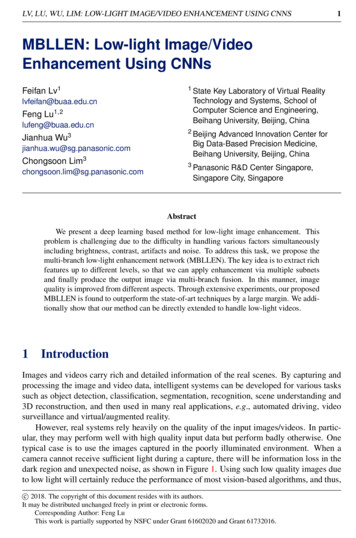
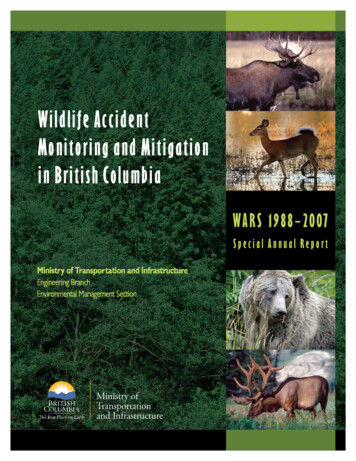
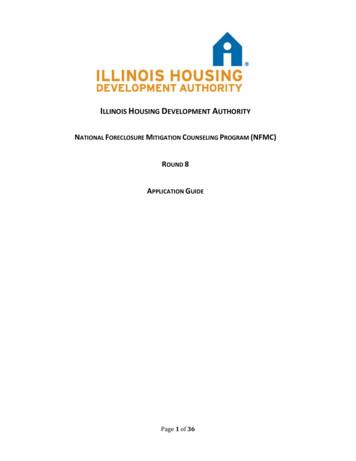
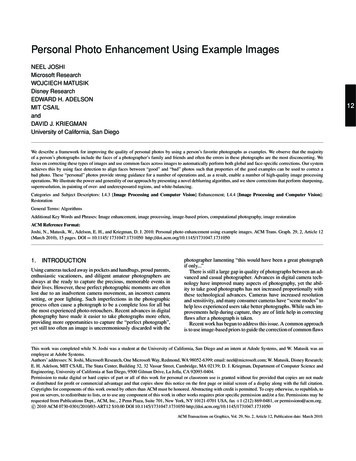
![[Concept Note] Polio Environmental Surveillance Enhancement Following .](/img/60/es-obr-nopv2-revision-20200601.jpg)
